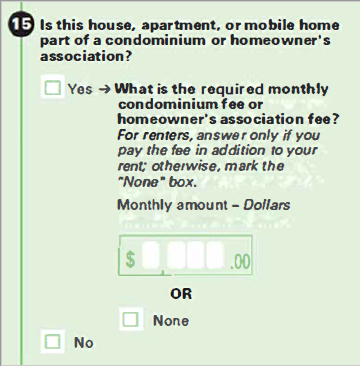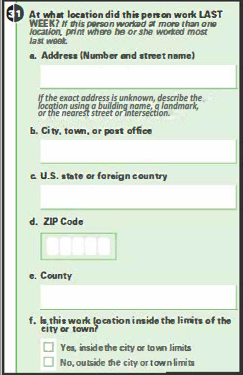Research Goals, Recruiting Requirements, Question Wording
Attachment A 2019 ACS POW-HOA Cognitive Testing Research Goals, Recruiting Requirements, Question Wording.docx
Generic Clearance for Questionnaire Pretesting Research
Research Goals, Recruiting Requirements, Question Wording
OMB: 0607-0725
Attachment A: American Community Survey (ACS) Cognitive Testing to Reduce the Burden and Difficulty of Questions
Research Goals, Recruiting Requirements, and Question Wording
November 13, 2018
Introduction
This round of cognitive testing will test the Condominium or Homeowner’s Association fee question and Place of Work question using the self-administered (paper) mode.
The 2015 American Housing Survey tested the inclusion of a separate homeowner’s association question on their survey. This resulted in a substantial increase in the number of respondents that reported belonging to a condominium, cooperative, or homeowner’s association from 8.7 million in 2013 to 25.5 million in 2015. The Department of Housing and Urban Development (HUD) has recommended that the Census Bureau incorporate homeowner’s association (HOA) fee wording into the current condominium association fee question in the ACS. Collecting the data improves the monthly owner cost estimate which is an important part of housing costs. The focus of this testing will be on whether or not respondents understand the difference between required and voluntary homeowner’s association fees and if respondents are reporting monthly fees instead of yearly fees.
The Journey to Work and Migration Branch (JTWMB) has found over the years that the order of the (and the type of the) address components in the workplace address question series may confuse some respondent. The JTWMB feels that respondent understanding will be increased by reordering the question. Prior empirical testing showed the phrase, “Is this within town limits,” may help in geocoding down to the place level, which may warrant leaving this phrase in the question series. However, this portion of the question series was flagged as part of the 2015 respondent burden research as potentially burdensome. The focus of this cognitive testing is to find balance between respondent burden and clarity for this series of questions.
Condo/HOA Fees
Research Goals
Do respondents know to report only the required costs of an HOA and not voluntary/optional costs?
Are respondents able to report the monthly cost of the HOA fees (not quarterly or yearly)?
Does probing using a multipart question with more Yes/No choices help? See Attachment F for this alternate wording.
Recruiting Requirements
Homeowners who are part of a required homeowner’s association.
Homeowners who are part of voluntary homeowner’s associations (i.e. neighborhood watch, community council, or social clubs)
Renters in areas with a homeowner’s association or condominium fee.
Table 1. Recruitment Goals for Condo/HOA fees
-
Goal
Minimum
Homeowners who are part of a required homeowner’s association
6-8
Homeowners who are part of voluntary homeowner’s association
2-4
Renters in areas with a Homeowner’s Association fee or condominium fee.
2
Proposed Wording – Paper:

Place of Work (PoW)
Research Goals
How easy or difficult is this question for respondents and why?
Are respondents clear about whether or not their workplace location is inside the limits of a city or town?
For respondents with no obvious fixed workplace location, what do they consider to be their primary workplace location?
For respondents who have a fixed location, but do not know their workplace address, how do they identify the location of their workplace? Does adding ‘landmark’ to the instructions provide a useful additional option for respondents?
Does the work address given in response to Question 31 match the work location the respondent identifies in later probing (using Google Maps or other probes)?
Recruiting Requirements
Employed people who work at home.
Employed people with atypical workplace locations (e.g. coworking spaces) or unclear or multiple workplace locations (e.g. Uber/Lyft drivers, truck drivers, operators of public transportation, construction or home repair workers, real estate agents, etc.),
Employed people in a standard working situation with fixed location.
Employed people who work outside of DC in a location whose “city limits” may be more ambiguous.
Households with more than one person who works outside the home are desirable in order to study proxy reporting; however, recruitment minimums below refer only to the primary respondent and not other household members reported by proxy.
A respondent may meet more than one of the below goals, therefore they add up to more than 12 people.
Table 2. Recruitment Goals for PoW
-
Goal
Minimum
Employed people who work at home
1-2
Employed people with atypical workplace locations (e.g. coworking spaces) or unclear or multiple workplace locations (e.g. Uber/Lyft drivers, truck drivers, operators of public transportation, construction or home repair workers, real estate agents, etc.)
3-4
Employed people in a standard working situation with fixed location
5-8
Employed people who work outside of DC city limits
4-5
Proposed Wording – Paper:
The instruction under “Address” are new: NEW: “If the exact
address is unknown, describe the location using a building name, a
landmark, or the nearest street or intersection.” OLD: “If the address is
not known, provide a street name, intersection, building name, or
landmark that describes the location.”

| File Type | application/vnd.openxmlformats-officedocument.wordprocessingml.document |
| File Title | 2019 ACS POW-HOA Cognitive Testing Research Goals, Recruiting Requirements, Question Wording_with CAPI specs |
| Author | Agnes S Kee (CENSUS/ACSO FED) |
| File Modified | 0000-00-00 |
| File Created | 2021-01-15 |
© 2025 OMB.report | Privacy Policy